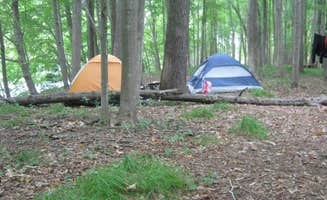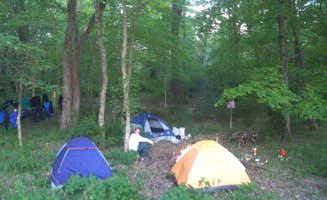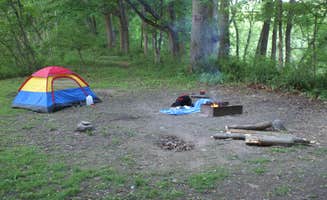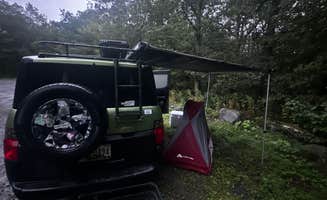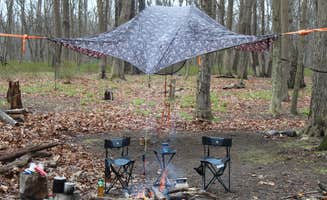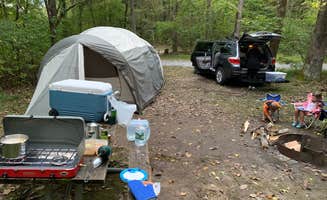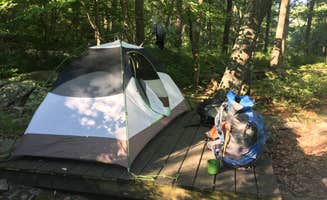Delaware Water Gap National Recreation Area camping straddles the border of Pennsylvania and New Jersey along a 40-mile stretch of the Delaware River. The region features elevations ranging from 300 to 1,600 feet and receives approximately 45 inches of precipitation annually, creating ideal conditions for diverse forest ecosystems. Most campgrounds in the area remain open from April through October, though winter camping options exist at select locations.
What to do
Hiking to waterfalls and scenic vistas: Trails near Dingmans Campground connect to numerous natural attractions. "Waterfall in pic was a 5 min drive from the campground and then a 40 hike. Worth it!" notes Rob M. The area features multiple hiking options within short driving distances.
Wildlife observation: The region's diverse ecosystems support abundant wildlife viewing opportunities. Near Camp Taylor Campground, visitors can experience the Lakota Wolf Preserve. "You can take a short hike up the mountain there to see the wolves in the sanctuary. There are moments by the fire you can hear them howl in the distance," shares Julie F.
Water activities: The Delaware River provides numerous recreation opportunities. At Kittatinny Campground, campers can combine camping with river adventures. "My college friends go here each year to meet up and we have so much fun. The group sites are great and perfect for our 30-50 people. Definitely go for the rafting/tubing package, it was the best part of the trip!" recommends Maggie K.
What campers like
Private waterfront sites: Several campgrounds offer direct water access. At Pickerel Point Campground, "We had site 100 and amazing views of the water from our camper. The trails were beautiful, recommend little falls trail," reports Kelly F. These waterfront sites often include convenient kayak launch access.
Wooded camping environments: Many campers appreciate the forest setting available at area campgrounds. "Our layout for this trip - May 31 - June 2 - Tent camping with 3 kids ages 12, 10, and 8. 2 other tent campers and 6 RVs... Location - beautiful set right up against the Delaware river. You can paddle it right from the campgrounds personal launch or start up river and land at their launch. Wooded sites are just as pretty sans the water views," explains Eric P. about Dingmans Campground.
Clean facilities: Campground maintenance receives consistent praise. "The bathrooms / showers are the cleanest we've ever seen at any campground. They are newly built or refurbished and spotless," reports one Dingmans Campground visitor. These well-maintained facilities enhance the camping experience throughout the Delaware Water Gap region.
What you should know
Reservation timing: During peak season, securing campsites requires advance planning. "We drive from Arizona to camp here for 6 weeks each year. It is truly a resort with organized activities like softball, archery and ceramics for kiddos. 2 pools, hot tub, sauna, lake beach and swimming. All sites are wooded, clean and spacious. We have been coming here for 11 years!" notes a visitor to Otter Lake Camp Resort.
Variable site privacy: Site configurations differ significantly between and within campgrounds. At Swartswood State Park, "There are about 50 camp sites but many of them, from 1 to 30ish are wide open with ZERO privacy. That said, it's great for large groups that book a few sites next to each other," explains Rob M. Research individual sites when booking.
Enforcement of rules: Campgrounds maintain different atmospheres regarding quiet hours and regulations. Camp Taylor visitor Dan B. notes, "Unlike many other campgrounds we've been to, they are very good about actually enforcing the quiet hours at night, so you can have an actual peaceful and quiet night around the campfire."
Tips for camping with families
Playground proximity: For families with children, consider sites near play areas. At Delaware Water Gap KOA, one camper reports, "Our camp site was great (52), backed onto a wooded area and a big playground was directly in front of us, which worked out perfectly since we have school age children."
Educational activities: Several campgrounds offer programs for children. "We enjoyed this campground! The pool was closed for the season when we were there, but the kids were able to enjoy an awesome playground and bounce pad. The roads were also great for them to ride on and get exercise. They REALLY enjoyed the art classes & the gem mining," shares Jimmy L. about Delaware Water Gap KOA.
Cabin options for new campers: Families new to camping might consider cabin rentals. At Stokes State Forest, "The cabins are reasonably priced and well-appointed, if a bit rustic. The interior features are just what you'd expect for getting away for the weekend. The main room has a bunk bed and two twins, a table with benches, two Adirondack chairs, a wood stove set into a fireplace," details one visitor.
Tips from RVers
Site access considerations: Some campgrounds have challenging approach roads. Kathy G. notes about Camp Taylor, "Water and electric hookups are standard, no sewer, but there is a dump station." Research access routes before arrival.
Site leveling preparation: Terrain throughout the Delaware Water Gap area can be uneven. One camper at Camp Taylor observed, "There is a section of RV spots that are each cut out in the woods so very private. Once you have backed into the spot and leveled out it's a good time." Bring adequate leveling equipment.
Hookup availability: Electric options vary between campgrounds. At Pickerel Point Campground, "We had full hookups (20/30/50 amp, water & sewer). There's no cable but we were able to pickup about 6 channels with our digital antenna," shares Debbie W. Check specific utility requirements when booking.


